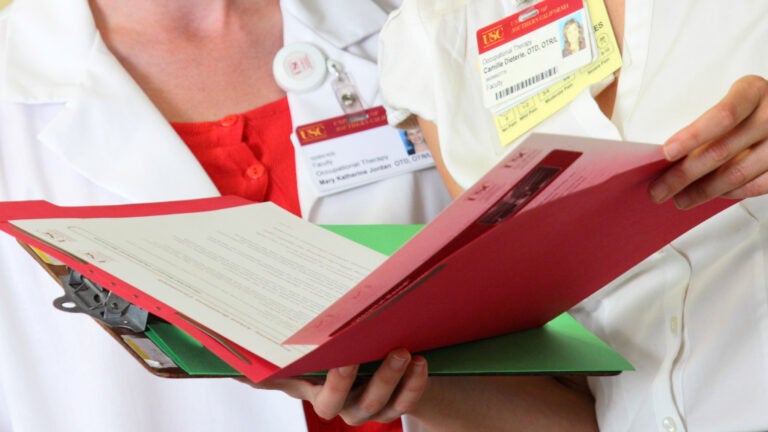
The researchers are interested in the traditional hard-copy format of records. (USC Photo/Philip Channing)
Who knew medical records had a ‘social life’?
Two USC researchers show how paper records impact interactions with health care practitioners
For more than a decade, electronic health records have been hailed as a means of improving health care quality, safety and efficiency. Yet in spite of the ongoing transition to electronic records throughout America’s health care system, two USC researchers are interested in their traditional hard-copy format and the value, if underappreciated, they still hold.
Occupational science doctoratal candidate Amber Angell and her mentor, Assistant Professor Olga Solomon, of the USC Chan Division of Occupational Science and Occupational Therapy examined data from Solomon’s multidisciplinary urban ethnographic study, “Autism in Urban Context,” funded by the National Institute for Mental Health.
For approximately three years, Solomon and her research team followed 23 African-American families with children diagnosed with autism spectrum disorder living in Los Angeles County — interviewing, observing and video-recording them in their homes, in doctor’s offices, in their children’s schools and out in the community.
The researchers asked nuanced questions about how the families, who face persistent disparities in autism diagnosis and interventions, used their child’s health records when seeking and acquiring autism services, how the records impacted their interactions with health care practitioners and how the records affected the families’ own meanings and experiences.
Records travel throughout the community
Angell and Solomon discovered what they subsequently termed the “social life” of paper records — the ways in which records are not strictly confined to medical contexts but instead literally traveled in cars, buses, bags and backpacks into homes, schools, clinics and throughout the community. For example, parents brought thick, chronologically ordered binders filled with records and documents to meetings in schools and doctor’s offices, often as a way of validating their own knowledge and expertise to professionals.
Angell and Solomon also learned how the subtleties of written descriptions in records can have consequences beyond the delivery of care. Descriptions of parents’ employment status, for example, positively or negatively influenced clinicians’ perceptions of them. For parents actively trying to project a “good parenting” persona, that task became more or less difficult simply because of descriptions in medical records.
Until recently, clinicians haven’t had to think much about how patients or families might feel about what’s written in their records.
Amber Angell
The researchers’ findings were published in a Social Science & Medicine article which, in December, received the 2015 Diana Forsythe Award from the American Medical Informatics Association. The winning article, “The Social Life of Health Records: Understanding Families’ Experiences of Autism,” was selected as a co-recipient from more than 30 other nominations. The award is named in memory of Forsythe, a pioneer of medical informatics — the interdisciplinary field of how data is used and managed in biomedical research, clinical care and public health.
The USC researchers insist that recognizing the “social life” of health records, regardless of digital or analog formats, is critical for improving family–practitioner relationships.
“Until recently, clinicians haven’t had to think much about how patients or families might feel about what’s written in their records,” Angell said. “Now, as electronic health records are changing how patients and families engage with their records, this is something for clinicians to take into consideration.”
